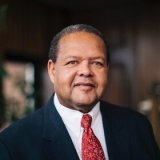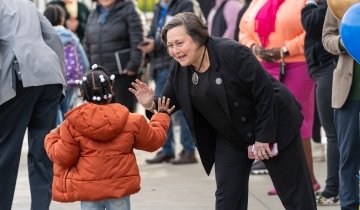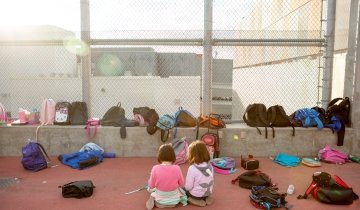On Sept. 7, 2023, the Orange Unified School District (OUSD) held a school board meeting with a number of items on the agenda, but the one that brought legions of community members and parents to contribute public comments was a policy on transgender parental notification. The proposed policy aimed to require the district to inform parents and guardians if their child asked to be called by a different pronoun other than the one assigned at birth.
Throughout the seven-hour meeting, over 120 parents and community members—including individuals who were not directly connected with the district—intensely expressed their opinions on the matter. Those in favor of the parental notification policy cited a parent’s right to know, while those opposed to the measure raised concerns about potential conflicts, privacy rights and child safety. Amid the community and parent comments and outbursts from attendees, the school board worked to maintain order and facilitate a productive dialogue. Despite the discord and polarization in the room, the meeting provided a platform for community members to voice their opinions.
At the conclusion of the meeting, the board unanimously passed the parental notification policy in a 4–0 vote. However, the OUSD board president and a fellow board member were recalled by voters in March 2024, and over the summer, Gov. Gavin Newsom signed a new law making California the first U.S. state to prohibit school districts from mandating staff to inform parents of their child’s gender identification change. When the new legislation takes effect on Jan. 1, 2025, districts like OUSD that have implemented such policies will be prohibited from enforcing them.
The scene in Orange is not unique. Across the nation, school board meetings have become increasingly contentious in recent years, with parents and community members expressing frustration and anger over a variety of issues. From critical race theory (CRT) to book bans, these meetings have become a battleground for differing opinions and ideologies. Amid much debate and division, Temecula Valley Unified passed a resolution that banned CRT in classrooms in 2022, and Murrieta Valley Unified rejected an 11th-grade social studies textbook proposed by teachers in 2023. Tensions run high as stakeholders seek to have their voices heard and influence the decisions being made by the school board. These meetings have become highly charged events, and the future of a child’s education hangs in the balance.
Education experts weigh in
To better understand what’s going on—at this meeting in Orange and across the nation—we asked three USC Rossier School of Education faculty experts on educational policy and three former school board superintendents to weigh in and help us make sense of the issues and what’s at stake.
These education experts reviewed select clips from the seven-hour board meeting from both sides of the policy argument. The experts shared their impression of the meeting, what strategies school boards may implement to address and de-escalate contentious issues, and what role education policy experts can play in helping school boards adopt and advocate for solutions.
Historically, school board meetings have drawn a smaller number of participants and have been, by all accounts, uneventful. But the events that occurred at the OUSD board meeting have become commonplace. “This kind of meeting became more popular during the early years of the pandemic, when people were worried about closing schools, mandatory vaccination and masking policies,” says Julie Marsh, USC Rossier professor of education. Meetings have transformed into what Marsh calls “performative spaces.” Streamed online meetings have become an opportunity and forum for individuals to comment on policy and speak to the public. More and more, signaling, symbolic actions by people and a well-rehearsed script have found a place at school board meetings to advocate for a particular political agenda.
As the former chancellor of the nation’s largest school district, New York City Public Schools, Rudy Crew, professor of clinical education at USC Rossier, has experienced his fair share of school board meetings. “There’s a line of demarcation between policy and administration, and school boards have a very difficult time staying on their side of that line,” says Crew. Whether it is race, gender or politics, the issues get twisted into this “very tight Gordian knot” that is difficult to untie at school board meetings, according to Crew. The relationship between the board and superintendent—with the board able to fire a superintendent at any time—is another point of contention, Crew says. Superintendents in Temecula Valley Unified and Palo Alto Unified have lost their jobs amid such strain.
Morgan Polikoff, co-faculty director of the USC EdPolicy Hub, offers that, while he has reservations about the very concept of school boards, this is how they are supposed to operate. Individuals can say and express what they want “as long as it’s germane to the issue,” Polikoff says. Board members consider the issues at hand and vote, and voters can recall board members they do not agree with. “I disagree with some parents and some board members” at the OUSD meeting, says Polikoff, “but it’s actually a very complicated issue. It’s not surprising to me that it’s difficult to come up with policy.”

These meetings raise important questions: Should individuals with no expertise in education, like board members, make decisions about complex issues they do not understand? While some members may have an education background, individuals interested in serving on a school board in California are not required to have a degree or background in education. “I think [the concept of school boards] is a crazy way to run schools in general, let alone on this very particular and highly politicized issue about which these folks mostly have zero knowledge,” Polikoff says. “But it’s how we do things in the U.S., and this is the predictable outcome.”
After reviewing the clips, former USC Rosier professor and superintendent to Long Beach and San Diego school districts Carl Cohn said, “It isn’t about the kids or the students. It’s about adult beliefs, about the red-blue divide in our country.” So much of this, Cohn says, is a larger adult performance brought to the local K–12 level.
So why are so many adults using school board meetings as a place to air grievances? One reason is that these meetings have been targeted to initiate potential policy changes on a broader scale, according to Marsh. And the strategy has been successful for some. In 2016, the El Rancho Unified School District school board saw a need for curricula that reflected the diversity of the student body and became first in California to make ethnic studies a graduation requirement. The local policy set a precedent, and in 2021, the California State Legislature passed a bill that mandated ethnic studies as a requirement for all public high school students across the state.
As a former superintendent with Tustin and Los Alamitos school districts, Gregory Franklin, a USC Rossier professor, has observed a strategy for those seeking to advance their political agenda. Individuals can and have built momentum for their cause at the school board level. “While [these politicians] might not be able to win statewide seats,” Franklin says, “they can win local [school board] elections where there might be larger concentrations of like-minded voters and begin to accomplish their agenda in these localities.”
Polarization on these issues can also be seen at a national level. The school board meeting in Orange “is a good example of what I’ve been studying, which is the ways in which school boards become pawns in broader political games,” Marsh says. While there were parents and community members expressing valid concerns, some individuals were not from the district and may have been brought in. These “traveling activists,” as described by the Los Angeles Times, are parents who travel to other districts to garner support for their cause. “Creating conflict in meetings is also a strategy for undermining confidence in public education,” Marsh adds. “This is the kind of politics that we’re seeing trickle down into school boards.”
Decisions made at heated school board meetings have potential long-lasting effects on students. According to Huriya Jabbar, associate professor at USC Rossier, many of these contentious policies are “undermining access and opportunity for different marginalized student groups.” The policies can limit exposure to a diverse and representative curriculum. For example, from Jabbar’s previous research on teacher turnover in Texas, teachers described feeling under constant threat from parents because of the school board battles around how and what educators taught. “There is a chilling effect from banning books or restricting what and how lessons are taught,” Jabbar says. “Those are the kind of long-term potential ramifications these school board conflicts have on students.”
Navigating debates constructively
Maneuvering through politically charged school board meetings can be challenging. Emotions can run high and tensions can flare. How can school boards move forward?
According to Franklin, school boards need to remember that, even if superintendents disagree with part of their community, they are still their community’s superintendent. They serve the district and, most importantly, they serve in the best interest of the students.
Because of the controversial nature of some of the topics brought up at school board meetings, individuals avoid discussing them and “oftentimes want to shut down,” Crew says.
“It invokes a culture of quietude and, unfortunately, suspicion,” Crew adds. “What superintendents have to do is ultimately work through and build the kind of culture where people will feel comfortable.”
Education policy experts can help school boards stay focused on the biggest issues: those that come from their own communities. Jabbar recommends that boards call on researchers and experts—such as those with legal and social science expertise—to weigh in. Establishing and collaborating within long-standing, research–practice partnerships may help.
Misinformation is another potential hurdle, and it has significantly affected the public’s understanding of topics like CRT and other educational issues. The transmission of information via social media is at an “exponential power,” according to Cohn, who adds that school districts are not often prepared to immediately respond to wild allegations. As with Temecula Valley’s ban on teaching CRT, board discussions on the issue have created confusion around education policy and shifted focus away from the actual needs of students. A lawsuit filed last year by several district students, teachers and the teachers union alleges the ban has “created an environment of fear and divisiveness on school campuses.”
“I think the best strategy is likely to be to ground [policy decisions] in the best evidence available,” Polikoff says. “Point to evidence and expertise, and ultimately let the chips fall where they may.” Although, this issue is especially thorny, as Polikoff suspects that the evidence on the parental notification policy is not as conclusive as advocates on either side would believe. Those in favor of notification likely believe that children experiencing gender dysphoria may change their minds, Polikoff explained, while those against notification may believe that outing children to their parents could result in worse outcomes for the children. “I’m not sure that evidence can really give us answers as to which policy position is better or not. Ultimately the decision on this issue probably hinges as much on norms and values as evidence per se,” Polikoff said. Evidence, however, can provide some support or leverage for those having to make these difficult decisions.
While school board meetings and the elected officials who preside over them may very well be flawed and a-far-from-perfect way to govern our public school systems, for the time being, they are what we have. So how then can school boards begin to bring back civil decorum into these public forums and keep in sight the most important thing—the students?
To start, effective communication, transparency, parental engagement and considering available research are all crucial elements for school members to incorporate into board meetings. Together, these elements can create an environment where difficult conversations can lead to constructive outcomes, ultimately strengthening the educational system and fostering a sense of shared responsibility among all stakeholders.








